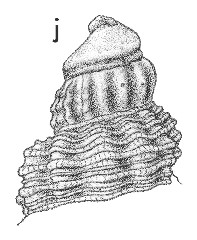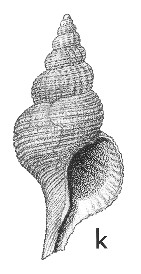
Revised descriptions of New Zealand Cenozoic Mollusca from Beu and Maxwell (1990)

 | Revised descriptions of New Zealand Cenozoic Mollusca from Beu and Maxwell (1990) | 
|
  (Pl. 49j): GS10963, R22/f6619A, Tainui Shellbed, Castlecliff, Wanganui, Castlecliffian (GNS) |
  (Pl. 49k): GS10963, R22/f6619A, Tainui Shellbed, Castlecliff, Wanganui, Castlecliffian (GNS) |
Beu & Maxwell (1990): Chapter 16; p. 365; pl. 49 j,k.
Synonymy: Fusus caudatus Quoy & Gaimard 1833, p. 503; Fusus vulpicolor G.B. Sowerby II 1880 (in 1842-1887), p. 78; ?Glaphyrina vulpicolor progenitor Finlay 1926c, p. 414; ?Glaphyrina vulpicolor annectens Powell 1934, p. 270; Neptunea caudata; Siphonalia caudata; Glaphyrina vulpicolor
Type species (as Fusus vulpicolor) of Glaphyrina Finlay, 1926
Classification: Fasciolariidae
Description: Large for genus but rather small for family (27-67 mm high; fossils rarely more than 45 mm high), tall and narrow, with tall, straight-sided spire, moderately long, straight, open, narrow anterior canal lacking fasciole, and short, evenly and strongly convex whorls with very deeply indented sutures. Sculpture of high, narrow-crested spiral cords, 6-8 on spire whorls and about 15 on last whorl and neck, with many fine threads on canal and fine secondary and tertiary threads in most posterior interspaces; low, evenly rounded axial folds extend from suture to suture on early spire whorls but fade out down spire of most specimens. Aperture oval, with thin lips. Protoconch highly distinctive, of about 2 whorls, the initial one highly irregular, with central "spike", concave upper slope and peripheral keel (suggesting it is an incompletely calcified "caricelloid" apex following a conchiolin embryonic protoconch, and so probably has direct development), second whorl taller and weakly convex, with narrow axial costae, passing gradually into teleoconch by development of spiral cords.
Comparison: Cernohorsky (1977b, p. 101) showed that the formerly enigmatic name Fusus caudatus Quoy & Gaimard, 1833 is an earlier name for the species long known as Glaphyrina vulpicolor (Sowerby, 1880). Modern populations of Glaphyrina caudata differ strongly around New Zealand; northern ones (Hauraki Gulf and northward) consist of relatively small shells with bright orange-brown colour, and with prominent axial costae continuing onto the last whorl, whereas southern ones (Otago shelf) contain much larger, white shells with axial sculpture on early spire whorls only. While this deserves more study, it makes it difficult to recognise as distinct subspecies the young fossils G. caudata progenitor (Castlecliffian, Wanganui) and G. caudata annectens (Te Piki, near East Cape, Haweran, oxygen isotope stage 7 = 200 000 years B.P.), which differ from modern shells only in the degree of development of their axial costae. We regard these forms as part of the variation of G. caudata. Older fossils (G. paucispiralis, Mangapanian-Nukumaruan, proposed as a subspecies of G. vulpicolor but accorded species rank by Beu & Maxwell (1990); and older unnamed taxa) have fewer, coarser spiral cords than Castlecliffian-Recent populations. The Nukumaruan-Recent species G. plicata (Pl. 42m) has a wider shell with much larger axial folds.
The protoconch (Pl. 49j) is figured separately for this species, as its pointed apex and concave sides on the first whorl so readily distinguish Glaphyrina caudata from the superficially similar Buccinidae Buccinulum, Aeneator, Cominella and Penion, all of which occur commonly with it at Castlecliff, and all of which have dome-shaped protoconchs with evenly convex whorls. This only partially calcified larval shell suggests that Glaphyrina has lecithotrophic (intracapsular?) development, which would help to explain its present variation around New Zealand.
Distribution: Castlecliffian-Recent. Recent, New Zealand (types of Fusus caudatus and Fusus vulpicolor); Castlecliff, Wanganui, Castlecliffian (type of G. vulpicolor progenitor); Te Piki, near East Cape, Haweran (oxygen isotope stage 7; type of G. vulpicolor annectens). Common in some offshore siltstone and silty sandstone beds (notably Pinnacle Sand and Tainui Shellbed) at Castlecliff, Wanganui, and occurs uncommonly throughout New Zealand Pliocene and Pleistocene rocks in offshore, soft-substrate environments.
Cite this publication as: "A.G. Beu and J.I. Raine (2009). Revised
descriptions of New Zealand Cenozoic Mollusca from Beu and Maxwell (1990). GNS
Science miscellaneous series no. 27."
© GNS Science, 2009
ISBN
978-0-478-19705-1
ISSN 1177-2441
(Included with a PDF facsimile file
copy of New Zealand Geological Survey Paleontological Bulletin 58 in CD version
from: Publications Officer, GNS Science, P.O. Box 30368 Lower Hutt, New
Zealand)